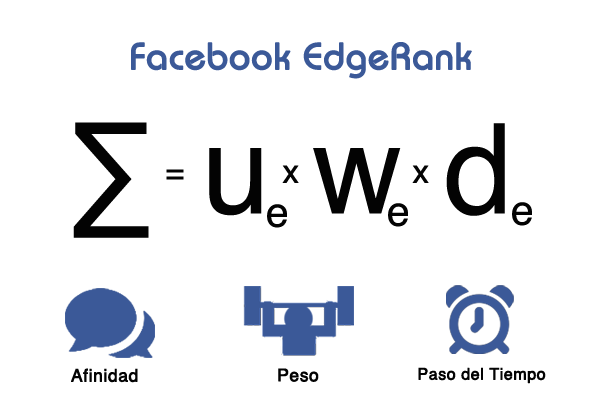Written by Anastasia Kurmakaeva
EdgeRank is Facebook’s algorithm that determines the reach of posts and the priority order of posts. EdgeRank determines how many users each post reaches, and in what position the post will appear on each user’s Facebook home page, also known as newsfeed.
Facebook defines the relevance of posts based on three parameters: affinity, interaction and time of the post.
- Affinity: The EdgeRank values the affinity between who has published the content and who receives it, taking into consideration if the user has interacted in the past with the publications of that page. That is why the more we interact with a page, the more its publications appear in our newsfeed.
- Weight: Facebook takes into consideration the interaction of the publication itself, and understands that, if many people have commented, shared or “Like” the publication, it is because it is of interest to them, it has “weight”, and therefore may also be of interest to other users.
- Passage of time: lastly, Facebook gives less relevance to content as more time passes since it was published. In other words, the relevance of a publication decreases over time.
How does EdgeRank work?
At the moment we make a post on our page, Facebook’s algorithm calculates that it should show the post to a certain number of our followers through their home page, but not to the total number of users who follow our page. This is what we call the “InitialReach ” or “Initial Reach” of that content. The percentage of users that will initially be able to see our content will vary depending on the value that Facebook gives to it.
However, if users interact with the content, i.e. share it, click the “Like” button or comment on it, the initial reach is increased.
Facebook understands that if the content gets interaction it is because it is interesting, and therefore will continue to show it to a greater number of users who had not received the publication to begin with.
Therefore, the fact that the followers of our page interact with our publications is very important because the amount of reach that will be achieved for the following updates will depend on it. In this sense, strategies to increase the number of fans that are not organic, i.e. that do not occur naturally, such as contests or advertisements of Facebook Ads very aggressive and poorly segmented, can work against us. If we increase the number of users that follow us, but these users are not really interested in our content, they will not interact with the publications of the page and therefore the EdgeRank of the same will be adversely affected.
EdgeRank References
What Is Facebook EdgeRank and Why Does It Matter? – Mashable
How EdgeRank works on Facebook – Hipertextual
